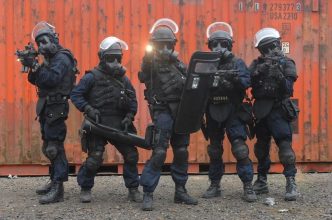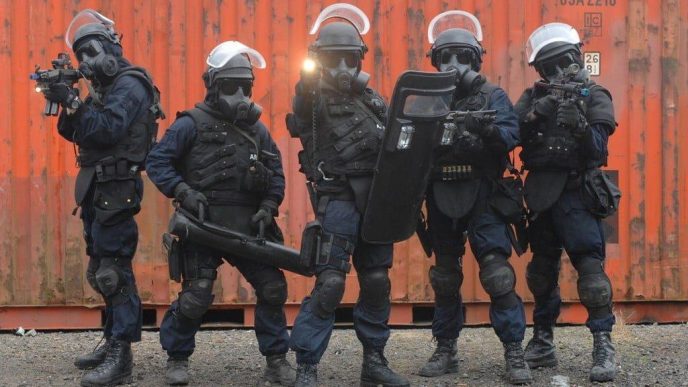The US Marine Corps ANGLICO (USMC ANGLICO) offer fire support and act as air/naval gunfire liaison companies of the United States Marine Corps. Their official name is Air Naval Gunfire Liaison Company (ANGLICO).
In combination with Navy personnel, they coordinate air, naval gunfire, artillery and other support of Marines as well as other US forces and allied units. As we already mentioned they are among the most trained and most eligible US special operations units.
The USMC ANGLICO differ in the fact they are trained to support forces outside the US Marine Corps. Accordingly, they are divided into four different areas, corresponding to the various levels of a foreign force’s organization.
USMC ANGLICO Organization
Division Cell
This group operates as the senior US Marine Corps fire liaison between the marine Air-Ground Task Force and the supported division headquarters. The equipment of this team highlight the planning and communication they’ll be involved with from the assigned headquarters. However, it would never be described as a desk job. While visiting smaller teams in Afghanistan, this company engaged in repeated close quarter combat with the enemy.
Brigade Platoon
The Brigade Platoon is protecting a brigade of friendly force and their equipment is mainly geared towards command post operations vice tactical combat.
Supporting Arms Liaison Battalion (SALT)
Also known as SALT, this battalion is trained to offer extensive fire support coordination for a supported battalion. This team is usually comprised of no more than ten Marines and Sailors. However, their training and experience often finds them involved in non-fire operations of the battalion being supported.
Firepower Control Team (FCT)
This team is the basic unit of USMC ANGLICO operations. Generally, there are two Firepower Control Teams (FCT) – though the number sometimes increases based on the number of team leaders available. The FCT Team is trained to take part in ground combat alongside a supported unit. The FCT will request, as well as control, air and fire support assets on behalf of the supported unit. Their duty often involves patrol, raids, and defensive operations.
Training of USMC ANGLICO
The Marines assigned to USMC ANGLICO must be proficient in a number of specialized military skills. They receive training in MOS (fire support), and some are required to complete airborne training and jump qualifications. They are also cross-trained with a number of US and Allied units around the world. The motto for this US Marine Corps special operations force – “Lightning from the sky, thunder from the sea”. This motto is proven many times during years, from USMC ANGLICO foundation, until today.
And still like many years ago, they are offering their services to their country…













I was a member of Colonel Timothy Geraghty’s Forward Air Control team in 1969. We demonstrated FAC live fire in Sardinia for Hellenic and Turk forces. You should have seen them cheer when we brought a Phantom through a valley, bank a mountain and torch a beach!
Operation Steel Tiger (Vietnam) declassified. 1st ANGLICO’s electronic shop at Marine Corps Air Station Kaneohe Bay tested the units that were being deployed to the Ho Chi Minh Trail. I was asked to accompany the two civilians, civilian clothes authorized, going to SE Asia with the units in January 1966. For this work I was awarded a letter of commendation from the Commander US Forces Pac. For outstanding technical support. I later was the NCOIC of the electronics shop for Subunit 1, 1st ALGLICO, MAC, Viet. Left Vietnam in August 1967.